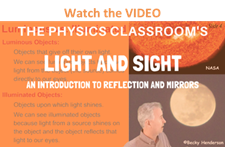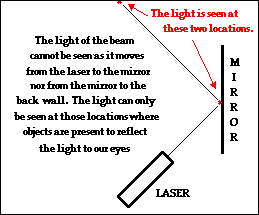Hold down the T key for 3 seconds to activate the audio accessibility mode, at which point you can click the K key to pause and resume audio. Useful for the Check Your Understanding and See Answers.
The bottom line is: without light, there would be no sight. The visual ability of humans and other animals is the result of the complex interaction of light, eyes and brain. We are able to see because light from an object can move through space and reach our eyes. Once light reaches our eyes, signals are sent to our brain, and our brain deciphers the information in order to detect the appearance, location and movement of the objects we are sighting at.  The whole process, as complex as it is, would not be possible if it were not for the presence of light. Without light, there would be no sight.
The whole process, as complex as it is, would not be possible if it were not for the presence of light. Without light, there would be no sight.
If you were to turn off the room lights for a moment and then cover all the windows with black construction paper to prevent any entry of light into the room, then you would notice that nothing in the room would be visible. There would be objects present that were capable of being seen. There would be eyes present that would be capable of detecting light from those objects. There would be a brain present that would be capable of deciphering the information sent to it. But there would be no light! The room and everything in it would look black. The appearance of black is merely a sign of the absence of light. When a room full of objects (or a table, a shirt or a sky) looks black, then the objects are not generating nor reflecting light to your eyes. And without light, there would be no sight.
Luminous versus Illuminated Objects
 The objects that we see can be placed into one of two categories: luminous objects and illuminated objects. Luminous objects are objects that generate their own light. Illuminated objects are objects that are capable of reflecting light to our eyes. The sun is an example of a luminous object, while the moon is an illuminated object. During the day, the sun generates sufficient light to illuminate objects on Earth. The blue skies, the white clouds, the green grass, the colored leaves of fall, the neighbor's house, and the car approaching the intersection are all seen as a result of light from the sun (the luminous object) reflecting off the illuminated objects and traveling to our eyes. Without the light from the luminous objects, these illuminated objects would not be seen. During the evening when the Earth has rotated to a position where the light from the sun can no longer reach our part of the Earth (due to its inability to bend around the spherical shape of the Earth), objects on Earth appear black (or at least so dark that we could say they are nearly black). In the absence of a porch light or a street light, the neighbor's house can no longer be seen; the grass is no longer green, but rather black; the leaves on the trees are dark; and were it not for the headlights of the car, it would not be seen approaching the intersection. Without luminous objects generating light that propagates through space to illuminate non-luminous objects, those non-luminous objects cannot bee seen. Without light, there would be no sight.
The objects that we see can be placed into one of two categories: luminous objects and illuminated objects. Luminous objects are objects that generate their own light. Illuminated objects are objects that are capable of reflecting light to our eyes. The sun is an example of a luminous object, while the moon is an illuminated object. During the day, the sun generates sufficient light to illuminate objects on Earth. The blue skies, the white clouds, the green grass, the colored leaves of fall, the neighbor's house, and the car approaching the intersection are all seen as a result of light from the sun (the luminous object) reflecting off the illuminated objects and traveling to our eyes. Without the light from the luminous objects, these illuminated objects would not be seen. During the evening when the Earth has rotated to a position where the light from the sun can no longer reach our part of the Earth (due to its inability to bend around the spherical shape of the Earth), objects on Earth appear black (or at least so dark that we could say they are nearly black). In the absence of a porch light or a street light, the neighbor's house can no longer be seen; the grass is no longer green, but rather black; the leaves on the trees are dark; and were it not for the headlights of the car, it would not be seen approaching the intersection. Without luminous objects generating light that propagates through space to illuminate non-luminous objects, those non-luminous objects cannot bee seen. Without light, there would be no sight.
A common Physics demonstration involves the directing of a laser beam across the room. With the room lights off, the laser is turned on and its beam is directed towards a plane mirror. The presence of the light beam cannot be detected as it travels towards the mirror. Furthermore, the light beam cannot be detected after reflecting off the mirror and traveling through the air towards a wall in the room. The only locations where the presence of the light beam can be detected are at the location where the light beam strikes the mirror and at the location where the light beam strikes a wall. At these two locations, a portion of the light in the beam is reflecting off the objects (the mirror and the wall) and traveling towards the students' eyes. And since the detection of objects is dependent upon light traveling from that object to the eye, these are the only two locations where one can detect the light beam. But in between the laser and the mirror, the light beam cannot be detected. There is nothing present in the region between the laser and the mirror that is capable of reflecting the light of the beam to students' eyes.

But then the phenomenal occurred (as it often does in a Physics class). A mister is used to spray water into the air in the region where the light beam is moving. Small suspended droplets of water are capable of reflecting light from the beam to your eye. It is only due to the presence of the suspended water droplets that the light path from the laser to the mirror could be detected. When light from the laser (a luminous object) strikes the suspended water droplets (the illuminated object), the light is reflected to students' eyes. The path of the light beam can now be seen. With light, there can be sight. But without light, there would be no sight.
None of us generate light in the visible region of the electromagnetic spectrum. We are not brilliant objects (please take no offense) like the sun; rather, we are illuminated objects like the moon. We make our presence visibly known by reflecting light to the eyes of those who look our way. It is only by reflection that we, as well as most of the other objects in our physical world, can be seen. And if reflected light is so essential to sight, then the very nature of light reflection is a worthy topic of study among students of physics. And in this lesson and the several that follow, we will undertake a study of the way light reflects off objects and travels to our eyes in order to allow us to view them.